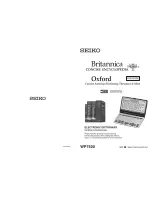Reviews:
No comments
Related manuals for CTK-6300in

Pocket
Brand: Zagg Pages: 18

3245WW - Wireless Keyboard With Bluetooth...
Brand: Palm Pages: 40

VersaKey Compact Series
Brand: ID Tech Pages: 16

Oxygen 88
Brand: M-Audio Pages: 51

VMK-88 plus
Brand: Studiologic Pages: 98

WP7500
Brand: Seiko Pages: 36

Celviano AP-24
Brand: Casio Pages: 33

KG9015
Brand: Loshine Pages: 2

G83-14300
Brand: Cherry Pages: 2

9808111
Brand: ZoomText Pages: 48

ICTB1007
Brand: Techly Pages: 2

Vigilus
Brand: Flybox Pages: 92

Dictionary & Thesaurus MWD-1470
Brand: Franklin Pages: 75

LANGUAGE MASTER DMQ-210
Brand: Franklin Pages: 20

switz2
Brand: Totally Wicked Pages: 2

Pipe X
Brand: Totally Wicked Pages: 9

GRIP VT75
Brand: Totally Wicked Pages: 19

orbis
Brand: Totally Wicked Pages: 24

















